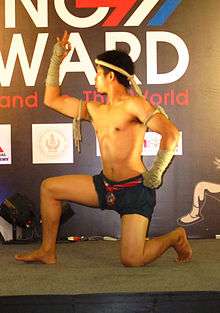Wai khru ram muay

Wai Khru Ram Muay (Thai: ไหว้ครูรำมวย, rtgs: wai khru ram muai, IPA: [wâːj kʰrūː rām mūɛj]) is a ritual performed by participants before fighting in muay Thai competitions. Known by different names, it also exists in muay Lao from Laos, pradal serey from Cambodia, and tomoi from Malaysia.
The wai is a traditional Thai greeting with the palms together as a sign of respect. Khru is the Thai form of the Sanskrit word guru meaning teacher. Ram is the Thai word for dancing in classical style, and muay means boxing. The full term can therefore be translated as "war-dance saluting the teacher", but Thai-speakers generally shorten it either to wai khru or ram muay. The ram muay shows respect and gratitude to the boxer's teacher, their parents, and to their ancestors. In the days when boxers fought in front of the royalty, the ram muay also paid respect to the king.
Upon entering the ring, fighters circle the ring in a counter-clockwise direction and pray at each corner. They bow their head at every corner three times in salutation to Buddha, Rama, and the sangha of monks. They then commence the ram muay, the movements of which are said to be based on Hanuman. The ram muay is a personal ritual, ranging from the very complex to the very simple, and often contains clues about who trained the fighter and where the fighter is from. The ram muay is accompanied by music, providing a rhythm to the boxer's movements.
See also
References
External links
| Look up ไหว้ครูรำมวย in Wiktionary, the free dictionary. |
| Wikimedia Commons has media related to Wai khru ram muay. |